CRUSHED2025: Worker Safety - Unlock India's Productivity Potential
- Safe in India

- Aug 12, 2025
- 6 min read
Updated: Aug 13, 2025
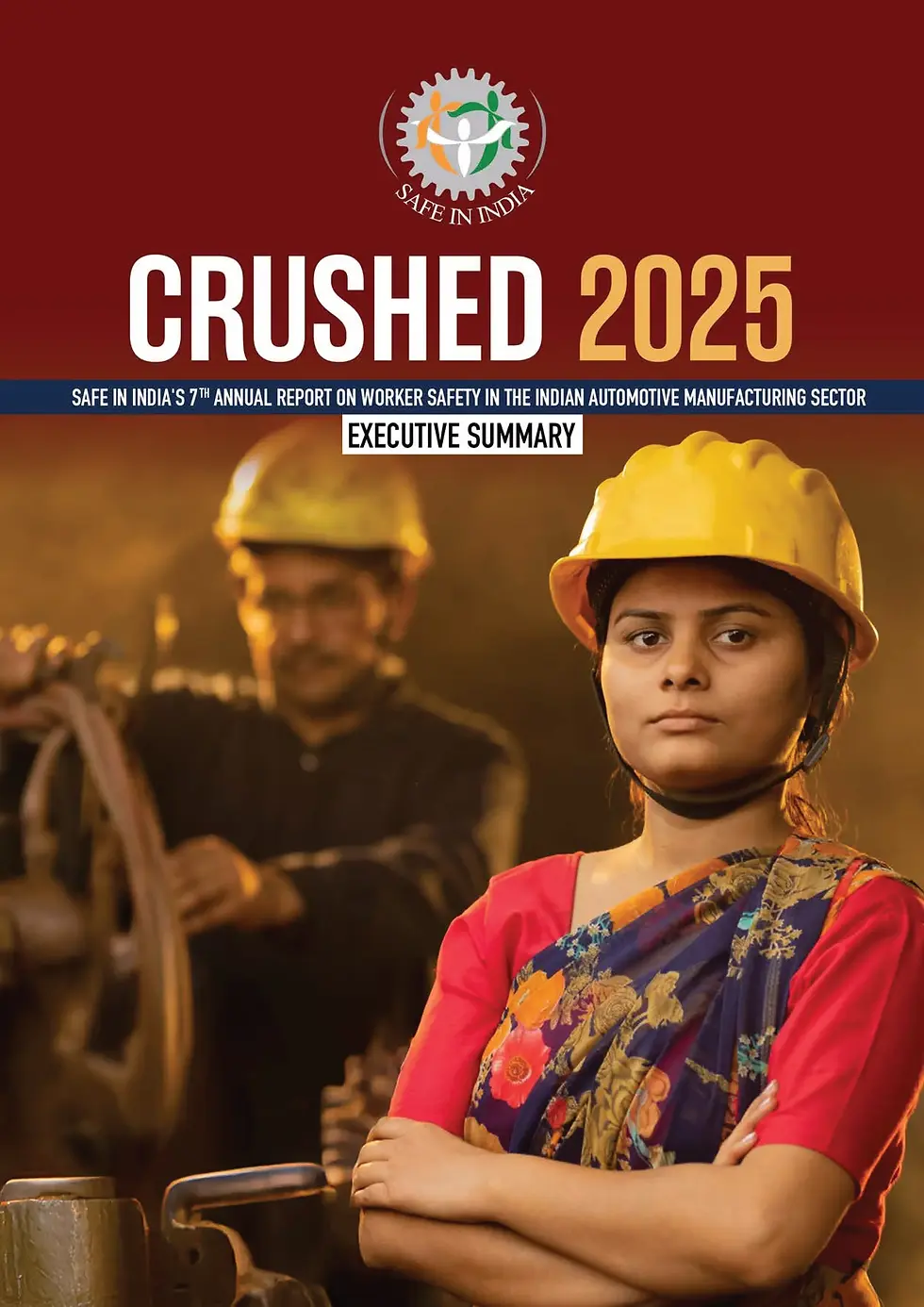
Introduction
We are delighted at the launch of CRUSHED2025, our seventh annual report on July 18, 2025.
This report continues to present uncomfortable evidence: thousands of workers in India's automotive sector supply chain still suffer preventable injuries, losing fingers, hands, livelihoods, and dignity.
Since 2016, we have assisted around 9,000 injured workers, with more than 7,000 of these cases originating from the auto sector.
The core message of CRUSHED2025 is clear: Although we have seen sporadic progress from a few automobile brands, worker Safety needs more attention in their supply chains and is essential for India, Indians, and Business.
New areas covered in CRUSHED2025:
Despite India's ratification of the ILO’s Hours of Work Convention (1919), several states have already embraced diluted protections:
Economic Survey 24-25 that supports this cause
New Labour Codes: policy aspirations vs on-ground realities
Analysis of factories from where SII helps more workers
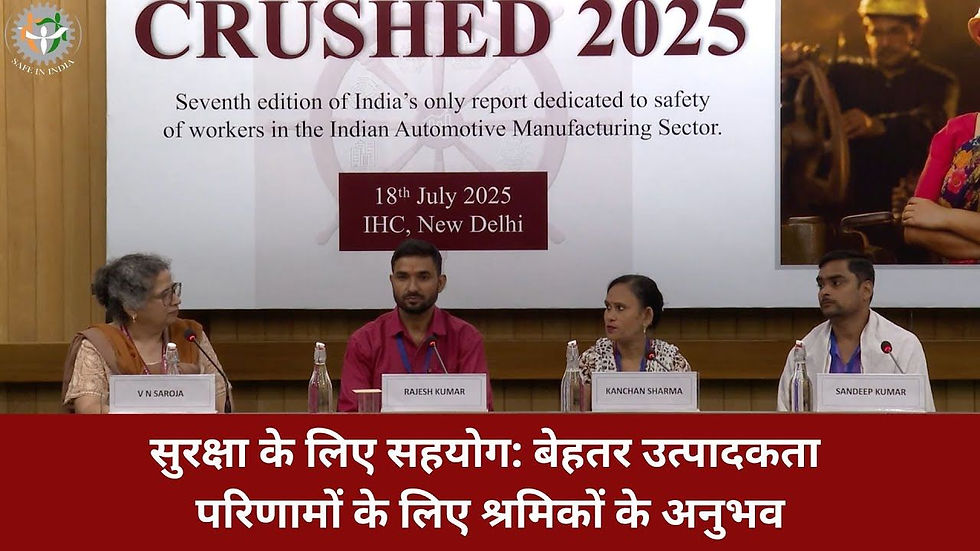
A panel discussion with three injured workers who explain the problem and solutions:
The panel included Mr. Rajesh Kumar, Ms. Kanchan Sharma, Mr. Sandeep Kumar and was moderated by Ms. Saroja (Head Worker Safety & ESIC Systemic Change).
Workers, through their experience, gave insights for better productivity outcomes. They also spoke about the poor working conditions including poor preventative maintenance, high production pressure and overwork as key factors leading to their injuries.
Additionally, they highlighted the role of automobile brands that they manufacture parts for, in ensuring a much safer work environment.
The same chapter also explores several critical and interconnected issues, including:
Under-reporting of accidents
Unsafe machinery and hazardous conditions
Lack of training
Wage theft and absence of pay slips
Gaps in implementation and enforcement
These findings offer a comprehensive view of how diluted enforcement and legal grey zones continue to harm India’s industrial workforce, and thereby Indian Labour Productivity.
“जो नए बंदे आते हैं/नई भर्ती होती है, उन्हें 10-15 मिनट मशीन चलाकर दिखाने को कहा जाता है । अगर उन्होंने जल्दी में 2-3 पार्ट पीस निकाल दिए तो पास कर देते हैं और मशीन पर काम करने भेज देते हैं। ऐसा नहीं होना चाहिए। ये देखना ज़रूरी है कि वो ऑपरेटर है भी या नहीं। कोई सर्टिफिकेट होना चाहिए उसके पास। मालिक को मुनाफ़े से मतलब है, सुपरवाइज़र को प्रोडक्शन से मतलब है। लेकिन वर्कर का तो हाथ चला जाता है।” – Kanchan Sharma, 48, Mathura (UP) Lost 3 fingers of her left hand while working in supply chain for Maruti Suzuki |
Expert panel on why worker safety is good for the workers, auto sector (business) and the country and how to improve it:
Another expert panel discussion including Dr Ajit Ranade (Senior Economist), Mr. Girish Arya (National Secretary, BMS), and Mr. Sunil Pahilajani (Strategic Business Advisor - Automotive Sector) was moderated by Mr. Sandeep Sachdeva (Co-Founder & CEO, SII).
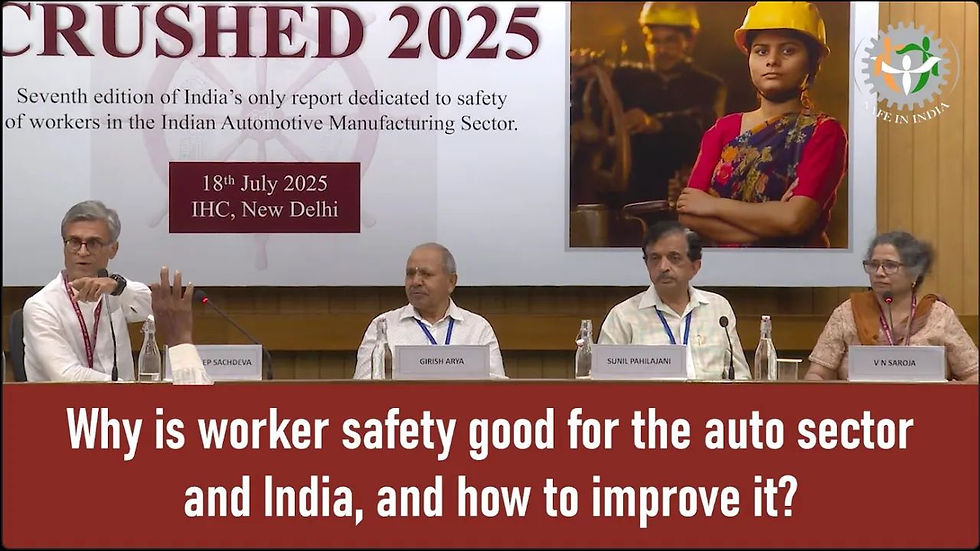
The discussion underscored the significant hidden costs of unsafe practices and the imperative for responsible business operations in the automotive industry. Experts emphasized that better working conditions enhance productivity and quality, highlighting safety as a core driver of business value. Discussions also focused on implementing structured solutions for effective regulatory support at the ground level, ensuring worker protection while aligning with sustainable business models, and identifying gaps in ESIC implementation to foster a sustainable and inclusive industry.
“There is a cost element, a loss of production element, and a loss of productivity element. This has an impact on healthcare and social security at the national level. Even a 1% loss to GDP due to poor working conditions would mean a loss of Rs. 3 Lakh Crore to the nation. Safe In India has estimated this to be Rs. 12 Lakh Crore. This is a hidden issue and is not discussed as much as it should be.” – Ajit Ranade (Senior Economist) “Workplace accidents must reduce, and proper reporting is essential. But when we get injured, we are often left without fair compensation. Big companies boast about worker provisions, yet in their supply chains, conditions are dismal – only production targets truly matter, and workers bear the brunt.” – Girish Arya (National Secretary, Bhartiya Mazdoor Sangh) “It is incorrect to claim that automobile brands (OEMs) lack control over lower-tier suppliers. When it comes to quality, they routinely engage with these suppliers to identify and resolve issues. If such engagement is possible for quality, it is equally feasible for safety. OEMs have both the responsibility and the capability to ensure safety standards across their supply chains. The only question is whether they have the willingness to act.” – Sunil Pahilajani (Strategic Business Advisor - Automotive Sector) "Worker safety in India has a business case given the dire state of affairs in many of these factories. They are losing machine time, materials, quality, time, legal and illegal costs and not creating a culture of professionalism. These workers are losing job and livelihoods. India is weighed down by higher disability costs, loss of skilled manpower, which industry constantly complains about, and underemployment and productivity loss. Do we have a leadership that can look beyond the short-term profits?" – Sandeep Sachdeva (Co-Founder & CEO, SII) "OEMs consistently overlook supply chain issues in BRSR reporting. Basic actions like maintaining accident registers are missed, largely due to a lack of data. This oversight needs urgent attention." – VN Saroja (Head-Worker Safety, SII) |

A few highlights from CRUSHED2025
Economic Imperative: Safety Fuels Productivity
CRUSHED2025 aligns with the Economic Survey 2024-25, linking Occupational Safety and Health (OSH) to improved Indian Labour Productivity and MSME professionalization.
Unsafe workplaces are a "macroeconomic liability". India ranks low in labour productivity. SII estimates, based on data from WHO Global Health Observatory, and WHO/ILO Joint Estimates, and methodology recommended by the WHO Commission on Macroeconomics and Health (Harvard School of Public Health and World Economic Forum,2011), India’s annual productivity losses due to injuries at ₹12.5 lakh crore, or 4.2% of national GDP. India must shift from "low-road" to "high-road" manufacturing through "better working conditions".

New Labour Codes: Policy vs. Practice
The report exposes a critical gap: Many business-friendly provisions are already in practice e.g. Long 12 hours days are now considered legal but worker protection provisions are "largely being ignored".
Unlawful Employment: 76% of injured workers worked over 60 hours/week (exceeding legal limits), with 92% not getting overtime on slips. 97% lacked appointment letters, and many were underpaid.

Dangerous Workplaces: 91% of workers' warnings about machine malfunctions were ignored. Over 90% of power presses causing injuries lacked safety sensors, a figure unchanged for six years. Inspections often only occur post-accident. Notably, 16% of machine injuries involved "helpers" who should not operate machines. Official accident reporting is a "fraction of the reality".

Workplace Accident Data: Drastically Underreported Despite Labour Code Mandates. SII assists over 1,000 injured workers in Haryana, every year yet DG FASLI reports less than 50 of these non-fatal accidents, indicating a vast reporting gap.

Persistent Factory Hazards & Strategic Opportunities

CRUSHED2025 identifies factory cases (anonymised) revealing a patterns of systemic, persistent injuries year after year. For instance, one Haryana factory had 68 injured workers; another in Maharashtra had 21, averaging at least three annually reported only to us. Truth will be a multiple.
Notably, 42% of factories with over 10 injuries are affiliated with ACMA, so it is not only a small factory problem

● 98% of the injured workers it has assisted since 2022 originate from the supply chains of six top automobile brands, in Haryana and Maharashtra.

Given this multi-brand challenge, OEMs have a clear opportunity to leverage their market position to foster systemic, data-driven changes that prioritize worker safety.
This opportunity is further amplified by new insights revealing seasonal patterns, with higher injury rates during Q2 and Q3, pointing towards the need for proactive supply chain monitoring during high-risk periods (April to October).
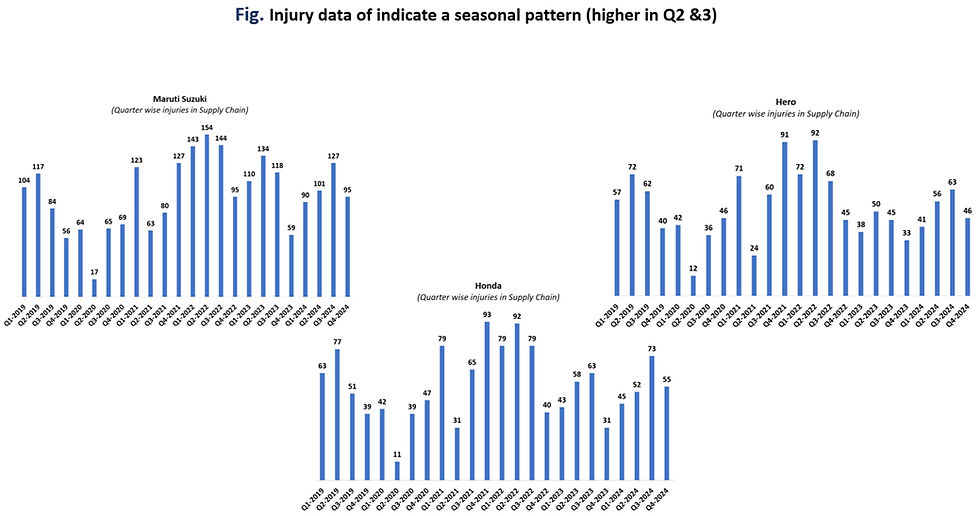
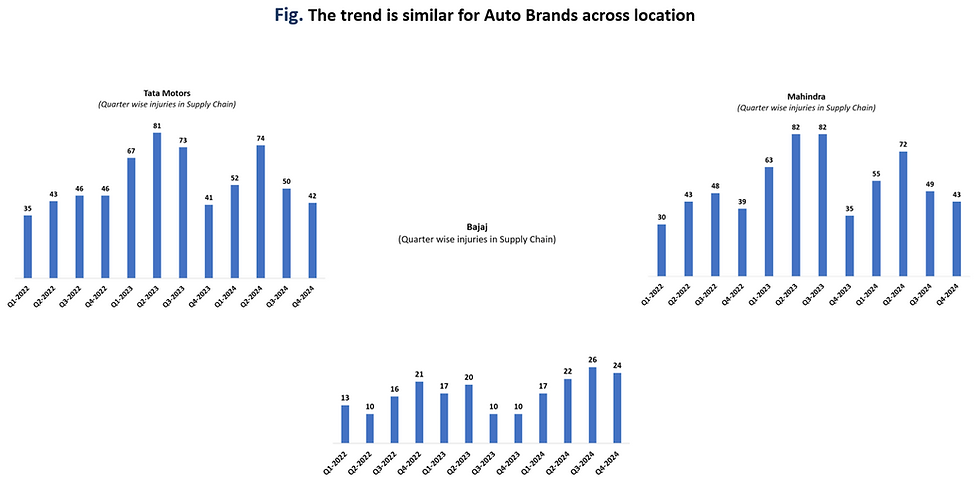
The report reiterates that worker safety is not just a moral obligation but a strategic business decision vital for sustainable growth and enhancing India's labour productivity. It urges top automobile brands to embrace this responsibility, actively support the professionalisation of their MSME suppliers, and integrate OSH as a core strategic priority across their entire supply chains.
The explicit recognition from the Economic Survey 2024-25 that 'better working conditions are good for business' reinforces the urgent need for India to transition from a short-term 'jugaad' approach to one focused on sustainable labour productivity, professionalism, and dignity for all.
Economic Survey 2024-25 supports SII's recommendation : Worker Safety is good for business

Absolutely spot on. I feel saddened that the car I drive is from one of these auto manufacturers. Am I inadvertently also responsible? I buy a car with the belief that the companies would be following ethical practices in their manufacturing processes and respecting the dignity of labour. But it seems this might not be true. I trust this report will help senior decision makers in these companies to become more conscious and concerned and thus more careful as they take manufacturing decisions. A Customer's Perspective |
Written by- Siddharth Raina
Senior Manager
Research & Advocacy
We urge the auto industry to lead the nation in improving this situation for workers, their own strategic gain and for the country.
Join hands to save hands.
We welcome any thoughts and suggestions at team@safeinindia.org











Comments